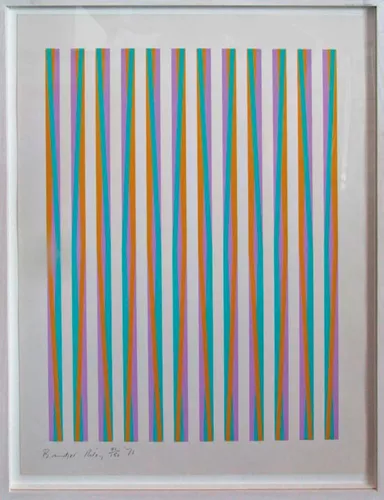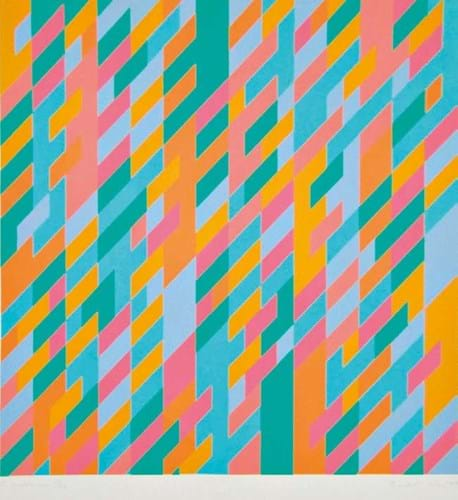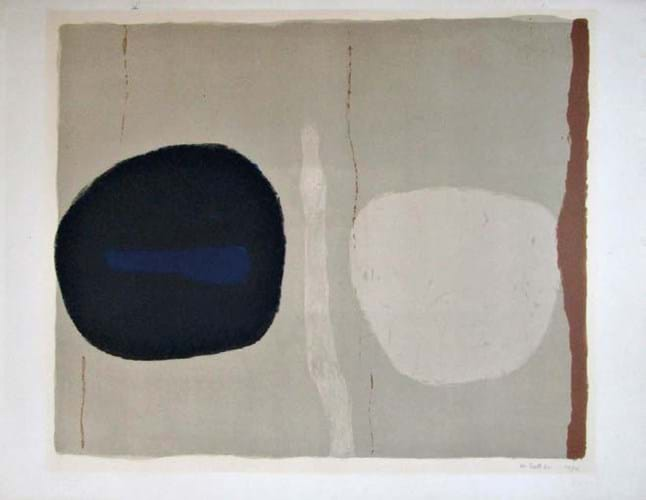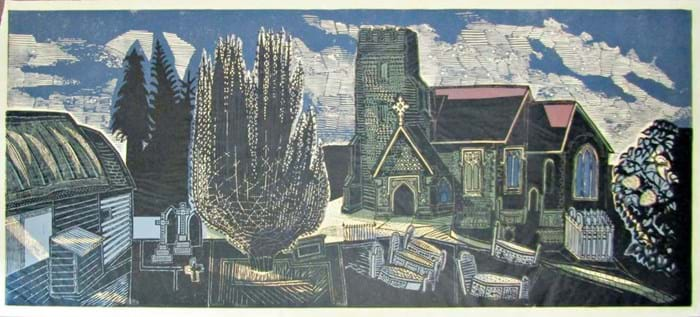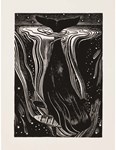While important works and major collections normally gravitate towards London, consignments showing how high levels of demand can be mustered outside the capital’s major houses do appear in the regions on occasion.
The problem for the provincial players is that these still tend to be rare events. This, in turn, makes it harder to gain vendors’ trust that they can handle lucrative or unusual lots and achieve prices equal to those that might be achieved in London.
Further afield
A recent test case came in Gloucestershire where an interesting collection was offered at Wotton Auction Rooms (18% buyer’s premium).
By posting a positive performance across a range of price levels, and with works selling to new and existing collectors in this category, it gave credence to the view that the Contemporary art market might well benefit from being less London-centric and spread more widely across the country.
It’s not often that a major collection of Post-war prints emerges in a regional sale but the impressive group included works by some of the main artists.
One of the highlights in terms of auctions staged outside London this summer, it was the kind of collection that might have got a bit overlooked in a major Contemporary art series in the capital but here, offered as a stand-alone sale, it had the chance to take the limelight.
The works came from the estate of Arnold Root, a well-respected architect from Bath who died last year. He was important local figure in heritage conservation having been the historic buildings architect for English Heritage in the south-west region for two decades.
He lived in a four-storey Georgian house in Bath which was crammed with paintings, works on paper and prints, many unframed and kept in drawers, under beds and on top of wardrobes.
Indeed, he had almost grown up as a collector, making frequent visits to shops and salerooms with his father, an avid furniture buyer who toured the country in a heavily laden Volvo estate (the one-time classic dealer’s mode of transport).
Mansion as saleroom
The collection Root amassed included multiple works by artists such as Bridget Riley, Ben Nicholson, William Scott, Dame Elizabeth Blackadder, John Piper, Bruce Mclean, Julian Trevelyan, Mary Newcombe and Mary Fedden, all of whom were strongly represented at Wotton’s sale.
The auction house thought that he simply kept buying works as interesting examples became available and it was possible that even he never realised the extent of his collection in its entirety.
Root had dealt with Wotton Auction Rooms for some years and it was his wish that his art collection be handled there when it came to be dispersed. The saleroom worked with his daughter Chloe and decided to go to town – quite literally as it staged the event about an hour away from the saleroom at Prior Park in Bath, the Palladian mansion built in 1742 by the postmaster and mayor of Bath Ralph Allen (1693-1764).
Now a private college, the location was chosen for its association with the collector. Root was involved in the re-building of the premises following a devastating fire in 1991 which gutted the interior.
With scenic views over Bath and a garden designed by Capability Brown, the setting proved a choice spot for a pre-sale exhibition to help stimulate interest. With estimates kept at modest levels, plenty of eager browsing was also registered once the online catalogue went live.
Overall, the 282 lots offered on July 22 raised a hammer total of almost £230,000. A second sale of works from the estate will be held towards the end of the year.
Bidders included a mix of private and trade buyers, as well as friends of Root who were generally astonished by the volume, quantity and variety of works that Root had quietly amassed.
Philip Taubenheim, managing director at Wotton Auction Rooms, said that the volume of bids via the room, phone lines and online buyers meant they managed only about 50 lots an hour.
“You could sense that all buyers, whether private or trade, were consistently bidding beyond the figures that they had initially set as their limit,” he said. “They all pushed each other along but no one seemed to regret any purchase once the hammer was down.”
Range of buyers
Works by Bridget Riley (b.1931) dominated the sale. Ten of her prints were on offer and all sold for a combined £70,660, contributing the nine highest prices of the auction.
Encouragingly they sold to range of buyers – seven different parties in all, including bidders from London, Northumberland and Ireland.
The top lot was Print for Chicago 8, a screenprint which was pitched at £2000-3000 and sold at £11,000 to a dealer.
The print was produced as part of a campaign by anti-war artists against the convictions of the ‘Chicago 8’ who were charged after a protest against the Vietnam War staged during the 1968 Democratic National Convention.
Signed and dated 1971, the 18in x 2ft (46 x 61cm) impression came from an edition of 150 (plus 15 Artist’s Proofs) and achieved the highest price yet for the edition at auction according to Artprice. The next highest for an example sold in the UK was one that made £7500 at Phillips in June 2021.
Coming next in the list in terms of the Riley prints here was a copy of Brouillard, a signed screenprint that the artist published herself in an edition of 85 (plus 20 artist’s proofs) and printed by Artizan Editions in Hove.
A larger screenprint measuring 3ft 3in x 2ft 11in (1m x 90cm), it was estimated at £6000-8000 and sold at £9400, in this case making the second-highest recorded price for this edition.
It was a similar case with the 1989 screenprint To Midsummer, a 3ft 1in x 3ft (93 x 92cm) screenprint from an edition of 100. Estimated at £4000-6000, it took £9300.
The only higher recorded price is the €13,000 (£11,280) for an example of this edition sold at Dorotheum in Vienna in May 2021.
Scott selection
Among the other artists featuring prominently in the Root collection was William Scott (1913-89). Nine prints by the artist all sold for a combined £26,400.
The artist was born in Scotland, grew up in Northern Ireland and lived in France for a spell in the 1930s.
His work was partly abstract but many examples also have an element of the still-life tradition that he admired.
One such example was Grapes, a 1979 lithograph in colour. At the Root sale, a 19¾in x 2ft 1in (50 x 64cm) signed and dated artist’s proof copy was on offer with a £2000-3000 pitch.
It sold at £3800 to a private buyer in Somerset, a price that represented the second highest for the edition at auction, only behind one that made £4500 at Christie’s in June 2020.
Two other Scott prints made £3300 each: a screenprint titled Still life with frying pan and eggs and the earlier and more abstract Benbecula.
The latter, a signed 22½in x 2ft 6in (57 x 76cm) lithograph from 1962, part of an edition of 75, overshot a £1500-2500 estimate and fetched the highest sum for this edition at auction so far.
Bawden sells out
Edward Bawden (1903-89) was another of Root’s favourite artists.
The Bath sale featured a total of 11 works which focused on prints of buildings and London markets.
With all of them selling, they raised a combined £27,500 with the bulk going to private buyers.
Bawden was a gifted printmaker. Linocuts, which he described as ‘very much a designers’ medium’, was his most commonly used form for his book covers, posters and fine art prints.
The top-seller here was a copy of Lindsell Church, a 2ft 2in x 5ft 3in (66cm x 1.6m) signed linocut from 1960 that was part of an edition of 40.
The subject was the church in the neighbouring village to where Bawden lived at Great Bardfield, Essex, and featured in a number of his works.
Estimated at £1500-2500, it sold for £3600 to a private buyer from Somerset.
Also selling above estimate was another signed linocut, Town Hall Yard, which, in this case, was an artist’s proof dated 1956. Surpassing a £2000-3000 estimate, it sold at £3300 – a price that overshot the $1800 (£1340) when it previously sold in 2017 at a Christie’s online sale.
Nicholson architecture theme

Ben Nicholson etching titled Patmos Monastery which was signed and dated 1967 and came from an edition of 50 - £3300 at Wotton Auction Rooms.
Another major name making a significant contribution to the bottom line at the sale of the Root collection was Ben Nicholson (1894-1982) with 14 works totalling £24,700.
The group comprised mostly etchings from 1960s – a period when his work focused on ‘clarity and the great art of omission’ according to his wife Felicitas Vogler. It included six simple depictions of architectural subjects that must have appealed to a collector like Root who was an architect himself.
One of them topped the Nicholson works here: a 18¼ x 23¼in (47 x 59cm) etching titled Patmos Monastery which was signed and dated 1967 and came from an edition of 50.
Knocked down at £3300, it more than doubled its estimate. Other than a copy that fetched slightly more at an auction in Switzerland in 2010, this was the highest sum recorded at auction for the edition.
Life of canine Riley
Another example of the Wotton sale achieving what would be considered notable prices even in London, it was one of the many results that seemed to justify Root’s decision to sell his collection with the Gloucestershire firm.
It must have been particularly gratifying for Root’s daughter who has now also taken up the collecting baton herself and, according to the saleroom, shares her home with an appropriately named Border Terrier puppy called Bridget Riley.


